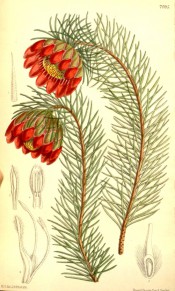Protea rosacea L.
Half hardy, compact shrub with slender branches, linear leaves, to 24cm, occasionally flushed red, and a perpendicular inflorescence composed of brilliant rose to crimson or mahogany bracts, buff in the centre, and reddish flowers in a crowded cone, in late spring. To 1.2m. [RHSD].
Horticultural & Botanical History
‘On the authority of Aiton’s Hortus Kewensis, Protea nana was introduced into England in 1787 by Francis Masson, a collector sent to South Africa from Kew; and it seems surprising that so attractive and striking a plant should have been lost to cultivation. In this respect it has shared the fate of a vast number of equally handsome or even handsomer species of Protea and its allies, not to mention other South African plants that ornamented the green-houses of our grandfathers. Of Protea itself, a genus containing upwards of sixty known species, about one-half have, previous to the first quarter of this century, been both cultivated and figured in Europe, chiefly in England, and thirteen of these in this Magazine. The dates of publication of the latter give a fair idea of the epochs during which their cultivation was encouraged: thus, of the first thousand plates there were of Protea four, all published between 1796 and 1806; of the second thousand, four again are of Protea (between 1809 and 1815); of the third thousand, four (between 1823 and 1827); since which, from 1827 to 1881, or out of 3838 plates, only one is of a Protea, and that published as late as 1881, to be followed in 1889 by the species here figured. And what applies to Protea applies to Cape plants in general, for I feel sure that a sifting of the figures of the species of Erica, Stapelia, and other South African genera published in this work, would give a like result. The history of the Australian Proteaceae, under a horticultural point of view, offers a similar example of a neglected branch during late years; but the flourishing epochs of these and Proteaceae differ, chiefly because the earliest Kew collectors were South African, the later Australian. Under Plate 6558 (Protea peticillata), I have given the reasons why Cape Proteaceae have fallen out of cultivation, and I must refer to the remarks under that species for further information on the subject.
Protea nana is a native of rocky places in the Cape Town district. The plant figured was raised from seed sent to the Royal Gardens by Professor MacOwan, Director of the Cape Town Botanical Gardens. It flowered in a cool green-house.’ [BM t.7095/1890 as Protea nana Thunb.].
History at Camden Park
Listed only in the 1857 catalogue [T.779/1857].
Notes
Protea nana Lam. (1791) = Protea acaulis Thunb.
Published Mar 21, 2010 - 03:20 PM | Last updated Mar 21, 2010 - 03:35 PM
| Family | Proteaceae |
|---|---|
| Category | |
| Region of origin | South Africa |
| Synonyms |
|
| Common Name | Mountain rose |
| Name in the Camden Park Record |
Protea nana |
| Confidence level | high |


